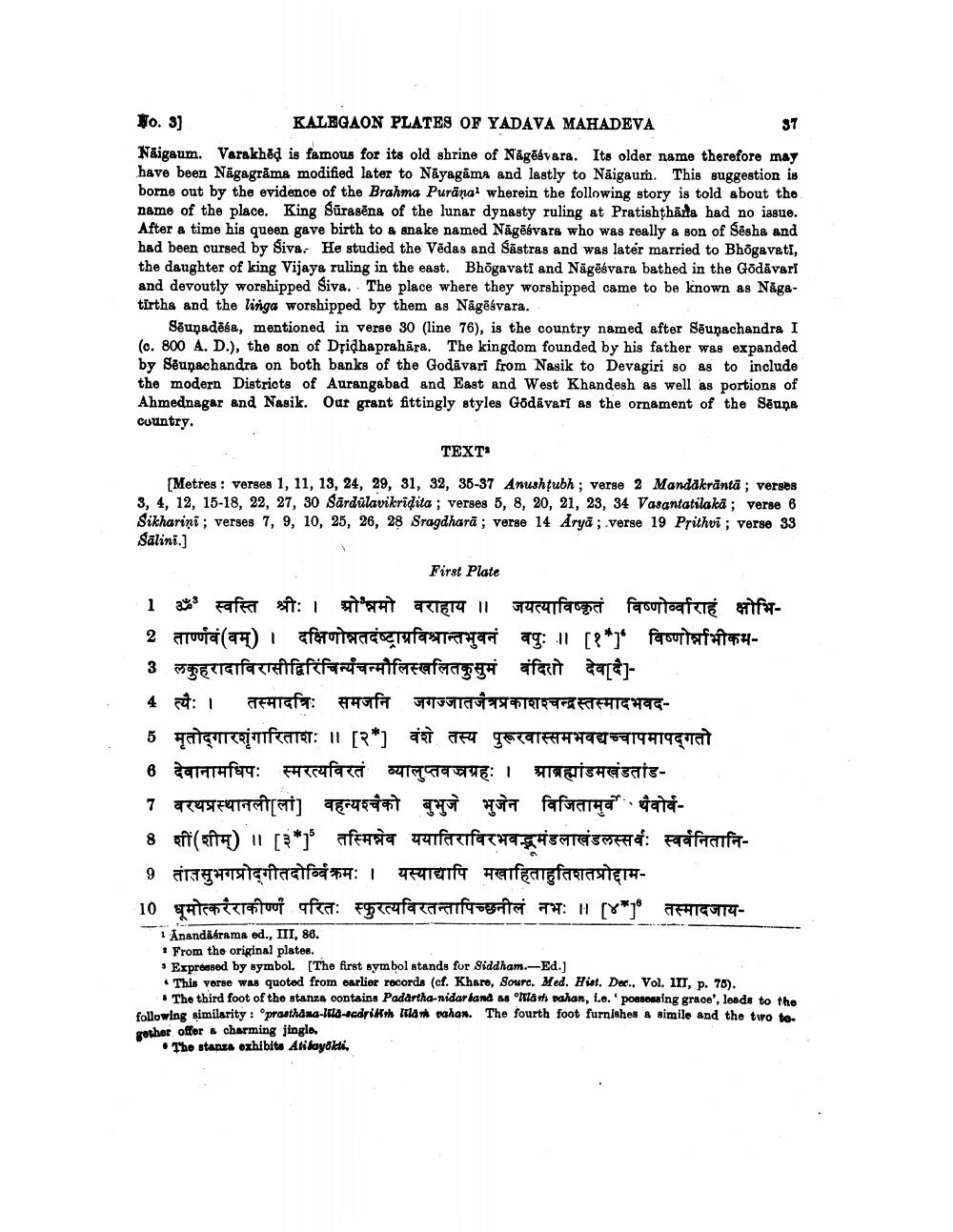________________
No. 3]
KALEGAON PLATES OF YADAVA MAHADEVA
37
Näigaum. Varakhed is famous for its old shrine of Nägeévara. Its older name therefore may have been Nagagrāma modified later to Nayagama and lastly to Naigaum. This suggestion is borne out by the evidence of the Brahma Purana1 wherein the following story is told about the name of the place. King Surasēna of the lunar dynasty ruling at Pratishthana had no issue. After a time his queen gave birth to a snake named Nagēévara who was really a son of Sesha and had been cursed by Siva. He studied the Vedas and Sastras and was later married to Bhōgavati, the daughter of king Vijaya ruling in the east. Bhōgavati and Nägeśvara bathed in the Gōdāvari and devoutly worshipped Siva. The place where they worshipped came to be known as Nagatirtha and the linga worshipped by them as Nägeśvara.
Sōupadāśa, mentioned in verse 30 ( line 76 ), is the country named after Sōunachandra I (o. 800 A. D.), the son of Dridhaprahāra. The kingdom founded by his father was expanded by Seupachandra on both banks of the Godavari from Nasik to Devagiri so as to include the modern Districts of Aurangabad and East and West Khandesh as well as portions of Ahmednagar and Nasik. Our grant fittingly styles Godavari as the ornament of the Seuna country.
TEXT
[Metres: verses 1, 11, 13, 24, 29, 31, 32, 35-37 Anushtubh; verse 2 Mandākrāntā; verses 3, 4, 12, 15-18, 22, 27, 30 Sārdūlavikridita ; verses 5, 8, 20, 21, 23, 34 Vasantatilakā; verse 6 Sikharini ; verses 7, 9, 10, 25, 26, 28 Sragdharā; verse 14 āryā; verse 19 Prithvi ; verse 33 Salini.]
First Plate
1 ॐ स्वस्ति श्रीः । श्रो नमो वराहाय ॥ जयत्याविष्कृतं विष्णोर्व्वाराहं क्षोभि2 तार्णवं ( वम्) । दक्षिणोन्नतदंष्ट्राप्रविभ्रान्तभुवनं वपुः ॥ [ १* ] विष्णोर्ना भीकम
3 लकुहरादाविरासीद्विरिंचिन्चन्मौलिस्खलितकुसुमं वंदितो देव[4]
4 त्यैः । तस्मादत्रिः समजनि जगज्जातजैत्रप्रकाशश्चन्द्रस्तस्मादभवद
5 मृतोद्गारशृंगारिताशः ।। [२] वंशे तस्य पुरूरवास्समभवद्यच्चापमापद्गतो
6 देवानामधिपः स्मरत्यविरतं व्यालुप्तवजग्रहः । व्यालुप्तवज्रग्रहः । श्राब्रह्मांडमखंडतांड7वरथप्रस्थानी [लां] वहन्यश्चैको बुभुजे भुजेन विजितामुर्वी थैवोर्व
"
8 शीं (शीम्) । [३*]5 तस्मिन्नेव ययातिराविरभवद्भूमंडलाखंडलस्सर्वः स्वर्वनितानि - 9 तातसुभगप्रोद्गीतदोर्व्विक्रमः । यस्याद्यापि मखाहिताहुतिशतप्रोद्दाम
10
धूमोत्करैराकीर्णं परितः स्फुरत्यविरतन्तापिच्छनीलं नभः ।। [ ४* ] तस्मादजाय
1 Anandaérama ed., III, 86.
From the original plates.
Expressed by symbol. [The first symbol stands for Siddham.-Ed.]
4 This verse was quoted from earlier records (of. Khare, Soure. Med. Hist. Dec., Vol. III, p. 75).
• The third foot of the stanza contains Padartha-nidarkand as Tash vahan, l.e. ' possessing grace', leads to the following similarity : prasthana-iila-scarism lilam vahan. The fourth foot furnishes a simile and the two together offer a charming jingle.
• The stanza exhibite Atibayokti,




